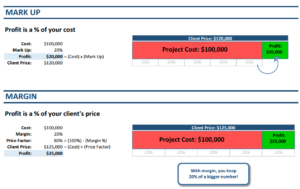In June, we held three one-day Markup and Profit classes in the Seattle area. A contractor we met sent us this note.
I attended your seminar in Everett a couple of weeks ago and found it and your book to be eye opening and immensely helpful.
I use a web-based estimating, scheduling and client communications program called ___. It has been great to work with, my clients love it, and it has helped me put estimates and proposals together quickly.
However, after reading your book and listening to your seminar, I was reviewing how it applies my markup. It referred me to this article in their help pages, and it seems to me that they use the terms markup and margin differently than you do. I switched it now to “Margin” and had it set as “Markup” before, and I think I had been shorting myself.
Discover more for your business with our
Markup & Profit Class
Michael talks about pricing jobs, working with employees & subs, contracts, profitability in 1-hour streaming videos.
Order it Here
He sent us the figure above from their help pages. It’s amazing and not in a good way.
I’ll give them credit for using the terms correctly. Markup is a percent of cost, margin is a percent of price. And their math calculations are correct.
The problem is their logic. Would you tell someone that their home will be more comfortable if they measure the temperature using Fahrenheit instead of Celsius? After all, 70 degrees Fahrenheit is much cooler than 70 degrees Celsius. That’s the type of logic they are using.
They’re saying that the formula you use will make you more profit. That’s baloney. It’s the numbers you use in the formula that determines your profit. You need to calculate your markup or margin using your business numbers. If you use your numbers, you’ll get the price you need to pay your job costs, overhead expenses, and make a reasonable profit. If you use someone else’s numbers, you won’t.
Of course a 20% markup is not the same as a 20% margin. That’s how math works. If you calculate a 50% markup (which is much more realistic than the 20% in the figure), your comparable margin is 33.3%. Being profitable isn’t determined by whether you use markup or margin to calculate your sales price.
If you’ve calculated your numbers correctly, you’ll arrive at the same sales price whether you use markup or use the comparable margin. We recommend using markup because there are fewer steps (as the figure shows). We show how to calculate your markup and margin in Markup & Profit Revisited. We also talk about the differences between markup and margin in a series of three blog posts on our website: “Markup, Margin and Why You Should Care,” “Using Gross Margin to Price Jobs? Better Use It Correctly” and “Markup, Margin . . . Does It Really Matter?“
Your profit isn’t dependent on what math you use. Your profit is dependent on knowing your business’s needs, calculating your own markup or margin correctly, then using it, correctly, every time.
Using someone else’s numbers could cost you money. If you don’t know what your overhead expenses are, and you assume you can use an arbitrary margin amount to make more money because that’s what your software company said, it will cost you money. Margin isn’t more profitable than markup, it’s just a different calculation.
Two other points. They’re calling it profit in the figure, but it’s really gross profit. It’s what’s left after paying your job costs. Gross profit is used to pay your overhead expenses; after overhead is paid, you have net profit. They make it sound like you’ll do great making a $25,000 profit, when in reality you still have to pay overhead expenses with that $25,000.
Finally, we recently heard a speaker say that using margin is a more sophisticated way to calculate your sales price; it’s how the sophisticated companies operate. Horsepucky. How can the type of math you use (division instead of multiplication) make you more sophisticated? And why should anyone care about calculating their sales price in a sophisticated manner? For heaven’s sake. Care about being profitable. And be careful who you listen to.
The knowledge and experience Michael Stone gained in his 60+ years in construction has helped thousands of contractors improve their businesses and their lives. He is the author of the books Markup & Profit Revisited, Profitable Sales, and Estimating Construction Profitably, and is available for one-on-one consultations.


